Breaking language barriers: how we built a multilingual AI bot for global teams

When your team spans multiple countries and languages, communication becomes your biggest challenge. At Orbios, with team members speaking English, Ukrainian, Russian, and Thai, we needed more than Google Translate—we needed intelligent, context-aware translation that preserves meaning and intent.
The challenge of multilingual teams
We've all been there: a message gets lost in translation, a joke falls flat, or worse, a critical technical detail gets misunderstood. Traditional translation tools fail because they:
- Translate word-by-word without understanding context
- Miss technical terminology and industry jargon
- Don't preserve the speaker's tone and intent
- Require manual copy-paste workflows that break conversation flow
- Can't handle code snippets, file attachments, or formatted text
Enter Orbios AI Bot
We built Orbios AI Bot (formerly Lingva Link) as a Discord-native solution that lives where our team communicates. The bot doesn't just translate—it understands.
How it works
Automatic detection and translation
When you send a message in any of our supported languages, the bot:
- Automatically detects the source language
- Uses recent conversation history for context
- Translates to configured target languages
- Posts the translation with your avatar for easy identification
- Hides the original in a spoiler tag for reference
No commands needed. No interruption to your flow. Just natural conversation.
Context-aware intelligence
Unlike basic translation APIs, our bot maintains a message cache (currently 5 messages per channel) to understand:
- What you're discussing
- Technical terminology being used
- Ongoing conversations and references
- Code snippets and technical documentation
This context dramatically improves translation accuracy, especially for technical discussions.
Server-specific configuration
Each Discord server can customize the bot's behavior with flexible translation settings. Teams configure which languages to support and how translations appear, reducing noise and improving readability for their specific needs.
Technical architecture
Under the hood, Orbios AI Bot integrates:
- Discord.js for Discord API integration
- OpenAI & DeepSeek for translation and AI assistance
- PostgreSQL via Hasura for message storage and analytics
- In-memory cache for real-time context (60KB per 100 channels)
- Hybrid message system with fallback mechanisms for reliability
Real-world impact
Since deploying Orbios AI Bot:
- 15+ active users across multiple servers
- 95%+ context accuracy for AI assistance
- < 5 seconds average response time
- Zero language-related miscommunications reported
- Measurable improvement in team coordination efficiency
Lessons learned
1. Context is everything
Simple translations fail. Understanding the conversation history and technical domain is crucial for accurate, useful translations.
2. Invisible is best
The best tools are the ones you don't notice. Auto-detection means our team doesn't think about language—they just communicate.
3. Flexibility matters
Different teams have different needs. Server-specific configuration has been essential for adoption.
4. Language detection is hard
Distinguishing between similar languages (like Ukrainian and Russian) requires sophisticated models and continuous tuning.
Future enhancements
We're actively developing:
- Improved language detection accuracy
- Voice message translation
- Integration with Jira, Trello, and GitHub
- Multi-server management dashboard
- Advanced workflow automation
Open source and extensible
Orbios AI Bot is designed to be extended. The architecture supports adding new languages, integrations, and features without touching core translation logic.
The bigger picture
Language barriers shouldn't limit who you can work with. By eliminating these barriers, we've unlocked:
- Access to global talent pools
- Diverse perspectives and approaches
- 24/7 productivity across time zones
- Richer, more creative collaboration
Orbios AI Bot isn't just a translation tool—it's infrastructure for truly global teams. And in an increasingly connected world, that infrastructure is becoming essential.